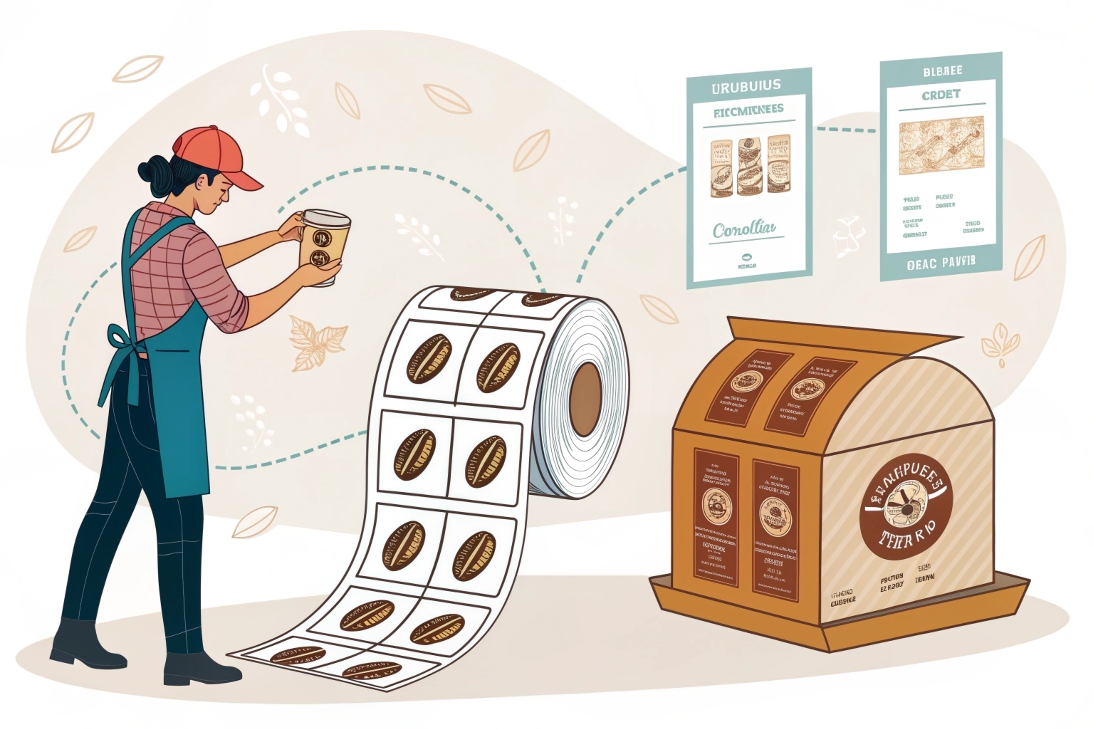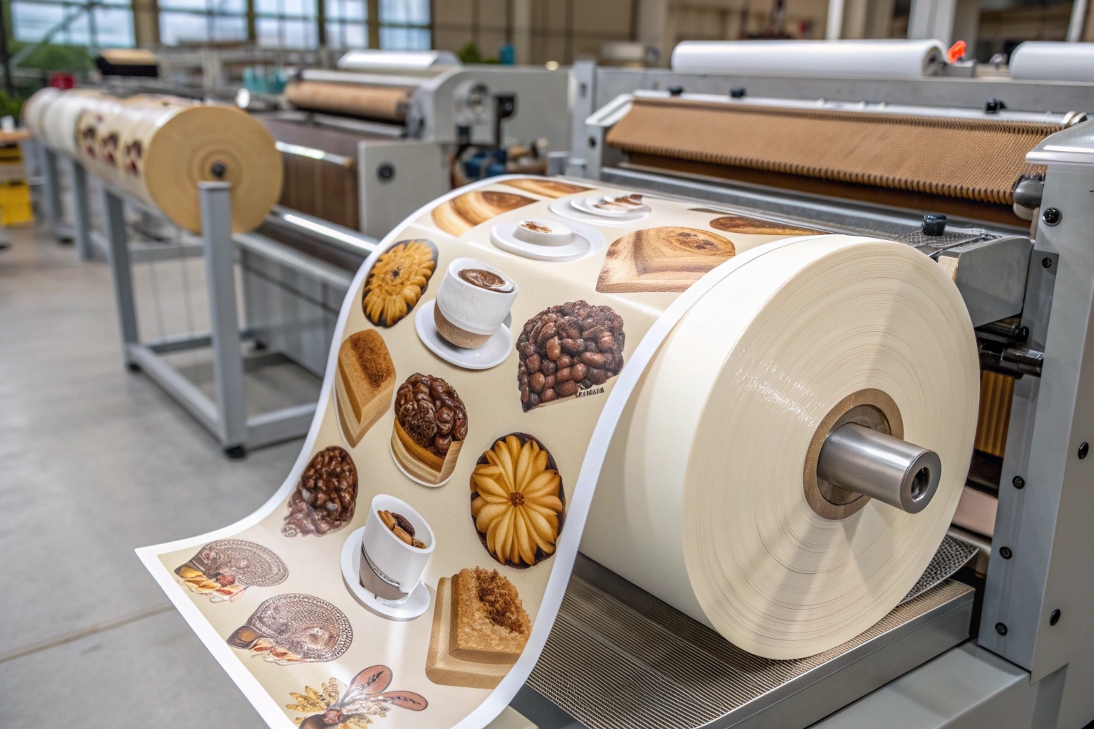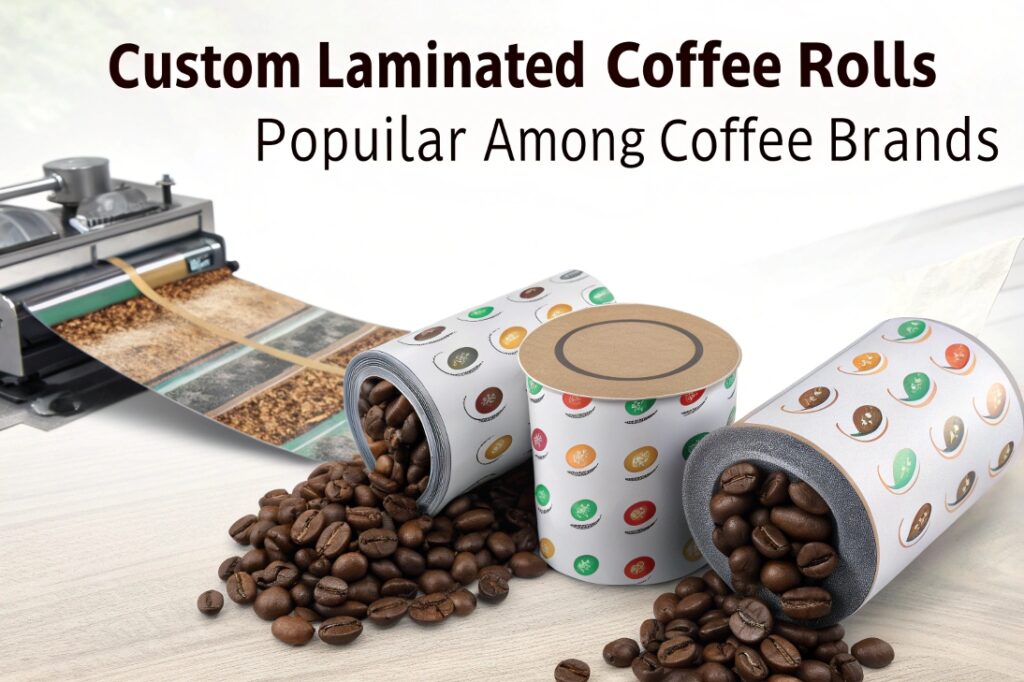Coffee brands love flexible packaging—but what makes custom laminated rolls so popular?
Custom laminated coffee rolls are pre-printed, multi-layered film rolls used for automated packaging of ground or whole bean coffee.
Last year, one of my U.S. clients asked me, “Can I print my coffee brand directly onto roll film, not just pouches?” That question started our collaboration on custom laminated rolls that now power his entire vertical form-fill-seal (VFFS1) packaging line.
Why are laminated rolls ideal for coffee packaging?
Laminated rolls are engineered to protect coffee and perform on high-speed machines.
Laminated rolls offer barrier protection2, customizable design, and efficient production for coffee brands.

Layered barrier protection2
Coffee is sensitive to moisture, oxygen, and light. Laminated rolls typically include:
- PET or BOPP: for print and shape retention
- VMPET or AL: for light and gas barrier
- PE or CPP: for heat sealing3
These layers are bonded using food-grade adhesive4, forming a high-performance packaging structure.
| Layer | Material | Function |
|---|---|---|
| Outer | PET/BOPP | Printing + durability |
| Middle | VMPET/AL | Barrier to oxygen/light |
| Inner | PE/CPP | Heat sealing, food contact |
Dive deeper: shelf life5 matters
The laminated structure extends shelf life5 from 3 to 12 months depending on the blend and storage. This is critical for both roasted beans and ground coffee, especially for export shipments.
At IMIPAK, we always match the lamination to your coffee's oxygen sensitivity, whether you need basic barrier for local delivery or high-barrier foil for overseas distribution.
How is a custom laminated coffee roll made?
Creating a custom roll is a technical process with multiple stages.
Laminated coffee rolls are made by printing, laminating, curing, and slitting multi-layer film materials.
The production steps:
- Design Approval – Your logo, color codes, and layout are confirmed.
- Printing – Using flexo or gravure on the outer layer.
- Lamination – Inner and middle layers are bonded with adhesive.
- Curing – Rolls are rested for 48 hours to ensure adhesion.
- Slitting – Rolls are cut to fit your packaging machine.
Dive deeper: how design affects production
Design matters. Transparent windows, zipper alignment, and degassing valve placement must be considered before printing. Even one wrong alignment in the roll film can affect 10,000+ packs.
That’s why we always provide dielines6 and digital proofs before we begin.
Why choose custom rolls instead of pre-made pouches?
Roll film or pouches? It depends on your production line.
Custom laminated rolls are ideal for automated filling, cost savings, and flexible size changes.
Benefits of using roll stock:
- Cost-effective: Lower unit cost than pre-made pouches.
- High-speed packaging: Ideal for VFFS1 or HFFS machines.
- Less warehouse space: Rolls take up less room than stacked bags.
- Custom size flexibility: Change pouch size without new mold.
Dive deeper: when not to use rolls
If you're a small roaster or don't have packaging machines7, pre-made pouches may be better. But for mid-size and industrial buyers like Mark (our typical buyer persona), laminated rolls reduce long-term packaging costs8 and increase throughput.
| Buyer Type | Best Option |
|---|---|
| Coffee Startup | Pre-made pouches |
| Mid-size Roaster | Laminated rolls |
| Export Business | Rolls with valve |
| Private Label | Rolls + large MOQ |
What printing options are available for laminated coffee rolls?
Printing turns packaging into branding. But not all methods fit every run size.
Laminated coffee rolls can be printed with flexographic or gravure techniques, depending on budget and quantity.

Flexo vs Gravure:
| Feature | Flexo Printing | Gravure Printing |
|---|---|---|
| MOQ | 3,000–5,000 meters | 10,000+ meters |
| Print plates | Photopolymer (cheaper) | Metal cylinders (costly) |
| Setup time | Shorter | Longer |
| Color detail | Good | Excellent |
| Ink type | Water-based or solvent | Mostly solvent |
Dive deeper: which to choose?
- Use flexo if you are doing test runs or custom SKUs.
- Use gravure if you need bold, photo-quality prints at high volume.
At IMIPAK, we support both print methods. For premium coffee brands, we recommend gravure for sharp lines and saturated blacks. For trial orders or limited editions, flexo keeps costs low without sacrificing quality.
How do I get started with custom laminated rolls?
Sourcing the right roll is not just about specs—it's about support.
To get started, you need to confirm size, material, print method, and your filling machine compatibility.
Step-by-step process:
- Choose your roll width and bag type – Flat bottom, gusset, or pillow.
- Select the laminate layers – Based on shelf life5 and product sensitivity.
- Approve artwork – Design files must follow dieline and CMYK rules.
- Confirm machine type – VFFS1, HFFS, or manual forming.
- Request free samples – Test seal strength, barrier, and print finish.
Dive deeper: questions to ask your supplier
Before placing an order, ask:
- Can the roll film work with my machine speed and heat settings?
- Will the zipper or valve be pre-applied, or added post-forming?
- How thick is the final laminate? (Typically 100–150 microns)
- What is the lead time? (Usually 10–20 working days)
By clarifying these early, you avoid delays and mismatches that could waste thousands in production.
Conclusion
Custom laminated coffee rolls offer branding, protection, and efficiency—all in one roll.
-
Learn about Vertical Form-Fill-Seal (VFFS) technology and its role in efficient packaging. ↩ ↩ ↩
-
Learn about barrier protection and how it preserves coffee quality by preventing moisture and oxygen exposure. ↩ ↩
-
Find out how heat sealing is used to create airtight packaging for coffee products. ↩
-
Discover the significance of food-grade adhesives in ensuring safe and effective packaging. ↩
-
Discover the importance of shelf life in coffee packaging and how it impacts freshness and flavor. ↩ ↩ ↩
-
Learn about dielines and their critical role in the packaging design process. ↩
-
Explore the different types of packaging machines suitable for coffee and their functionalities. ↩
-
Explore strategies to minimize packaging costs while maintaining quality and efficiency. ↩


